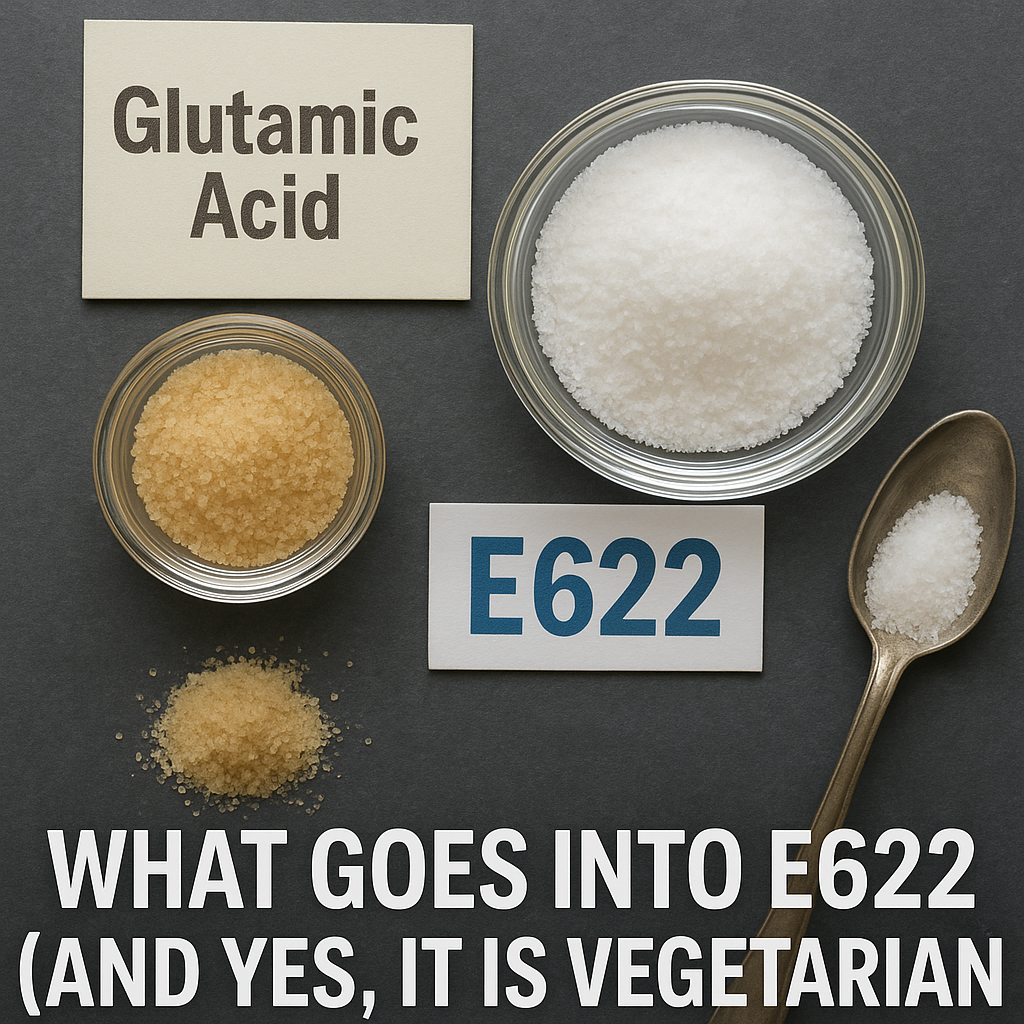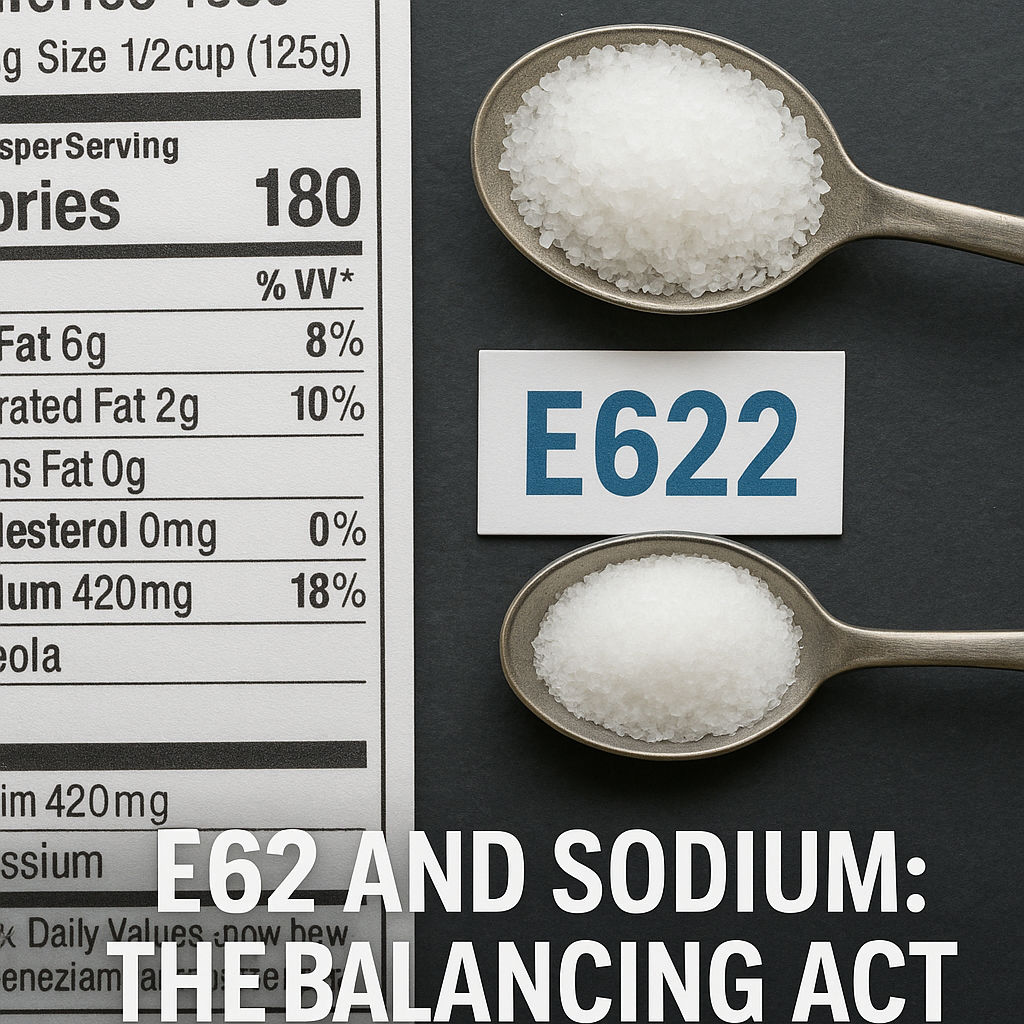
Intro: The Code On Your Plate
To be honest. The majority of us do not read food labels carefully. And even when we do, when we encounter the codes such as E622, we simply shrug and pass on. What are they talking about after all, just a sequence of letters and numbers?
However, the following truth is that: these small codes can tell us much about what we are consuming.
Examples include e622 or monopotassium glutamate, a substance found in treats, as well as instant noodles, ready-made foods, and salty snacks. It does not sound much, but it plays a significant role in the taste of our food as well as how our bodies react with it.
Now we can remove the veil and discover what is E622, from where it comes, what is used for and whether you should have a place for it in your pantry or not.
So what is E 622?
E622 is the potassium salt of the naturally occurring glutamic acid, an amino acid. That might not sound like an excellent idea, but the truth is that glutamic acid is a protein building block of sorts. It can be found in everything, including meat, cheese, and even mushrooms.
E622 is not merely any compound, though. It is a flavor enhancer, in the same line as its more established brother, MSG (monosodium glutamate, or E621).
They are also added to the increase the umami taste,, the salty, rich, mouth-watering taste which each of us likes in our food like ramen, meat stock,, soy sauce.
The major discrepancy between E622 and sodium is that E622 is made of potassium hence works as a superior substitute in cases where sodium is a challenge.
How Umami came to be: Why E622 is so popular
Time out. What is the purpose of food companies using food chemicals like flavor enhancers, such as E622?
This can be simply answered as follows: to enhance the taste of food.
In an era of shelf-stable prepared food and convenience with low prices, the creative developers of manufacturing houses struggle to maintain any authentic taste in their products — particularly when aiming for low-salt or low-fat content. In the case of savory flavors that need to be simulated, even during the reduction of other ingredients, E622 serves as an effective tool.
So, the next time you are munching on some instant noodles and make a face at the thought of why the broth is so deep and rich, you could probably be left thinking the E622 did some of the heavy lifting.

What Goes Into E622 (And Yes, it is Vegetarian)
Among the great myths surrounding E numbers, the claim that all are synthetic, or rather, chemical,, is particularly noteworthy. Some of those other additives are synthesized in labs, but E622 is produced through fermentation.
It is like this:
- Some bacteria ferment natural sources of sugar (sugar beets or cane molasses).
- This fermentation forms glutamic acid.
- The resultant glutamic acid is then neutralized with potassium to give monopotassium glutamate-E622.
The final product is turned into a water-soluble white crystalline powder that is ready to be used as a flavor enhancer.
And yes,, usually it is vegan, since there are no animal products involved.
In Your Kitchen: Where E622 Is present
When you consider whether or not you consume E622, you may want to check your food and ask yourself whether you consume:
- Instant soup and ramen noodles
- Seasoning packets, a mixture of seasoning
- Fake meat and sausages
- Frozen meals
- Salty foods: Chips, crisps
- Gravies & Can Veg
It is not only the taste, but also cost-effective. The use of E622 can help businesses lower the content of real meat, salt, or spices while maintaining a gratifying taste.
MSG vs. E622: The Story of Two Glutamates
The public perception of MSG has been rather dire since the 1960s, due to the dubious reports of symptoms under the name of Chinese Restaurant Syndrome. Several scientific reviews have declared it safe,, but a wide range of consumers remain cautious about it.
That is where E622 comes in. It contains many of the same flavour-enhancing effects of MSG, with lower levels of sodium, and a new name, which can be perceived as safer, at least to people with an interest in their diet.
However, it is essential to note that E622 and MSG are both subject to the same action due to their glutamic acid content, and your body does not distinguish much between the two. Provided you have used MSG without any problem, you should have no problem with E622.
Is E622 Safe? What Science and Regulations Say
Now to the point, is E622 a safe thing to eat?
This is what is known:
- The European Food Safety Authority (EFSA) and the U.S. FDA approve E622.:
- It is referred to as Generally Recognized as Safe (GRAS).
- In the general population, there is no evidence of harmful effects consistently supported by reviews.:
With this said, individuals with certain health-related conditions, such as kidney disease, can be advised to be careful of potassium levels,and thus restrict intake of E622.
In addition to that, a tiny proportion of individuals complain of being sensitive gto lutamates, and they develop symptoms such as headache or flushing when food contains high amounts of glutamates. Nevertheless, they are not regular and scientific researches fail to reproduce them consistently.

E622 and Sodium: The Balancing Act
We have mentioned this before, but it’s worth exploring further. The excess intake of sodium (salt) in the diet has been identified as a risk factor for high blood pressure and cardiovascular disorders. It is due to this that the low-sodium foods are growing in demand.
E622 is a clever trick-it imparts pungent flavour without any addition of salt.
And extra: potassium is the mineral that is an E622 mineral, and keeps fluid levels balanced and assists the body in nerve communication. It may also help curb the effects of high sodium. So, it may turn out that when you are cutting the salt in your food intake, E622 is not bad; it can be even helpful.
Clean Labels vs E Numbers: Consumer Psychology
Have you ever come across a product labeled No MSG that still tastes incredibly savory?
Precisely, it could be E622 or yeast extract taking its toll.
A growing trend in the industry is ethical labelling or clean labelling, where firms change the names of ingredients to sound healthier rather than using E-numbers.
Therefore, it is better to name the product like “E622” and the label would show the name monopotassium glutamate, which would somehow not seem so frightening.
It is the same material but sold differently.
That way, you may be avoiding E-numbers, but you are probably still getting glutamates, albeit indirectly.
And it is not, I suppose, a bad light in which we are dressing it, not E622?
It is a medium-level reaction.
1 His/her/ its/ the reason to use/ burden of using/reasonability of use of E622:
- You would fain take all the taste And all the pep And none the pepper:
- You already eat vegetarian or plant-based food, and what you need is the taste of umami:
- You eat what is prepared food sometimes, and you like the way it tastes:
2 There are two reasons why you never want to see it (or not even to find it):
- You are suffering from chronic kidney disease or you have a Low-potassium diet:
- Here you have experience of the sensitiveness of the glutamate already:
- You desire to be a person who lives without additives at all:
To the most significant number of people, however, E622 is no more something to fear than any other functional and safe ingredient.
Substituting E 622 fornaturale food products
Nature has many choices on the off chance that you are into DIY cooking and need to develop vivacious flavor with no additives:
- The species of mushrooms that are dried are shiitak.e
- green, besides, anhydroic dried tomatoes, or a stew of them
- Old type ( i.e., genesera rang parmesan )
- Seaweed:
- Soupy foods include miso, soy sauce, and and kimchi.
- Nutritional yeast:
All of these are natural sources of glutamates packed naturally, and produce truly exquisite flavours that have a very natural taste.
The reflections on the Post Film: The Taste is not to be frightened of
Food additives may also be E622,, and it can appear to be a quiet,, especially when it is a structure with a behind-the-scenes identity. But once you get to know what it is (a natural derivative of an amino acid that you body burns daily), much of its mystique is removed.
E622, used in a sensible manner, is therefore a way of having a healthier diet since it can lower the sodium content without affecting the taste. And not being necessarily right to all people, there is little demonstration that it seriously harms more people.
As fear of the world dominates the food industry through marketing, you must know so that it can assist you. You will know what it refers (when you come across E622 on the label) again, and what it does not next time you see it on the label.




1 thought on “E622: The Secrets to Savory in your food – What you need to know”